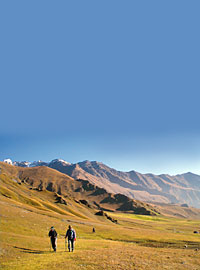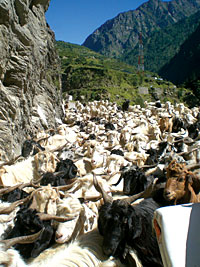 ALL PICS: KUNDA DIXIT |
By the second day, we'd lost count of the number of times we were asked that question. But also by the second day it was clear that trekking in India is one of that vast country's best kept secrets.
The Indian Himalaya is overshadowed by Nepal's higher profile in trekking and mountaineering, but the scenery is just as spectacular and in many ways the walks are more accessible and hassle-free. Remote valleys that in Nepal would take a week to walk to can be reached in a day-and-a-half drive from New Delhi.
In Nepal you are never too far from a settlement, but here in the Garwhal Himalaya the hikes are usually through wilderness areas. Which means one has to camp, and the 'tea house' trek model that has made Nepal's tourism such a big economic pump for mountain valleys is less common here.
The Nepal Himalaya is a series of 'himal' massifs more than 8,000m high sliced by deep gorges. The treks in Nepal are along the bottoms of these valleys (which restricts the views) and the ups and downs when traversing them are much more vertical.
Here in Garhwal, the mountains are much more manageable. The steep parts can be negotiated by road, so the ridge walks are gentler and the views of surrounding peaks like Bandar Punch, Kalanag, Jaunli and Srikanth are consistently superb. Comparable ridge walks in Nepal would be the Panch Pokhari trek in Sindhupalchok, the Panchase trek in Kaski or the Tijure rhododendron walk in Terathum.
 |
What in Nepal are known as kharka are called bugyal here, but unlike in Nepal these high altitude grazing pastures are extensive and you can trek for days from one meadow to another, walking on a velvety carpet of flowers. It is Khaptad multiplied ten times. The resplendent impeyan pheasant, their monal to our danfe, is also Uttaranchal's state bird.
These mountains were lost to the British after the Sugauli Treaty of 1816, but there are still signs of Nepal everywhere. The Gangotri Temple was built by Amar Singh Thapa and the place is full of pilgrims from all over Nepal taking the holy dip. The road signs point to famous battlefields from our history books like Nalapani and Kangra. The Garwhali dialect people speak here is close to the trans-Karnali lingo in western Nepal. Rising living standards in Uttaranchal mean that it is hard to find locals to carry loads, so the trekking porters are from Nepal.
Most, like Pasang Lama from Sindhuli, go back to Nepal in the trekking season and work here during the monsoon carrying loads for pilgrims. "It's not like working in Nepal, here we are outsiders," complains Pasang.
 |
Ravi Rawat, who leads treks in Ladakh and Himachal in the company of Nepali porters, knows 'Resham Phiriri' by heart, but with slightly modified lyrics:
"Resham phiriri, resham phiriri...
Rafting ma monkey,
Trekking ma donkey, resham phiriri...
Kodo jharyo makai jharyo
Jyan payeko chhaina..."


